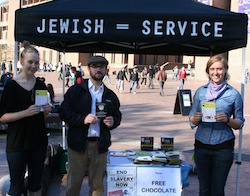By Emily K. Alhadeff , Assistant Editor, JTNews
Maybe you’ve felt guilty after eating through too many of those yellow mesh bags of chocolate gold coins during Hanukkah. Now here’s something else to feel guilty about: Your chocolate gelt might have child slavery at its source.
According to the U.S. Department of State, at least 100,000 children work in the cocoa industry in the Ivory Coast, where approximately 40 percent of the world’s chocolate comes from. Ten percent of those children are enslaved or trafficked. Fifty percent of that chocolate is eaten in the United States. Despite the illegality of child labor and slavery, the practice persists due to lack of governmental regulation and accountability. These practices occur in other countries such as Ghana and Cameroon as well.
Fair-trade chocolate and coffee campaigns have long been on activists’ radars, but until now they have never affected the Festival of Lights.
“The goal with this is to have no Jewish organization buy gelt with child slavery [involved]” said Robert Beiser, campus director at the social justice organization Repair the World at Hillel at the University of Washington. “And we’re starting with the Seattle Jewish community.”
Beiser calls himself a Jewish abolitionist. He works with the Not for Sale campaign and Freedom Shabbat, national programs that bring awareness to modern-day slavery. Beiser, along with the Kavana Cooperative, is at the forefront of what is officially known as the Fair Trade Gelt Campaign.
“As a people that reminds ourselves every year…that we were once slaves in the land of Egypt, it’s paramount that we lead around the world,” Beiser said.
“It’s about the core Jewish narrative,” said Rabbi Rachel Nussbaum, Kavana’s executive director. Nussbaum pointed out that buying fair-trade gelt is not exactly the point. Rather, it is thinking about the food we eat and “kashrut as a broader, more ethical system.” The campaign is in step with others in the larger Jewish community, like the new Tav HaYosher ethical kashrut movement.
Beiser said the campaign has two components: One is “rewarding the companies that have taken on the extra responsibilities of ethically sourcing their cocoa,” and the other is asking large companies to change their policies.
Kate Koester, Kavana’s social justice chair, said Kavana has always been interested in local food issues, and fair-trade chocolate was a subject on members’ minds. She connected with Beiser when they planned a Freedom Shabbat at Kavana last April.
“For last year’s [Hanukkah] party we ended up using Equal Exchange small rectangular bars,” wrote Koester by email, referring to a popular brand of fair-trade products. “No foil. No mesh bags. We posted a sign next to the Equal Exchange bars about why this gelt was different. It raised attention, but people still missed the silver foil discs. So, that is why the issue of the difficulty of finding fair trade gelt was brought up again during the Freedom Shabbat.”
Koester, Kavana and Beiser approached Theo Chocolate to ask them for a new product line.
“They were very responsive,” Koester said. She said Theo fair-trade gelt is due to hit shelves in time for Hanukkah 2012. A Theo staffperson said the company could not confirm the new line until December of this year.
In the meantime, fair-trade gelt can be found through Divine Chocolates (www.divinechocolate.com) and Sweet Earth Chocolates (sweetearthchocolates.com). Divine Chocolates’ gelt are certified kosher.
Now the time has come for the inevitable question: How much more expensive is fair-trade chocolate than the standard?
Coin by coin, one Divine chocolate costs 27¢, a 17¢ premium over the generic gelt. In other words, the fair-trade brand costs about 270 percent more than the non-fair–trade brand.
But when you buy the cheaper gelt, “you’re missing out on an opportunity to free someone from slavery,” Beiser said. “To give children in West Africa an education…you’re saving someone who could have been abused and kept in bondage.”
“We have children who will be playing with the gelt,” Koester said. “And we don’t want our children to play with chocolate that was made by child slaves. That perpetuates the issue of slavery.”
Could it really be that simple? Beiser said the issues are complicated, but yes. He explained that profits from fairly traded chocolate go back to the communities, where organizations monitor the exploitation of children. Because of this reinvestment, children who were once enslaved are now free, and in school.
The easiest way to think about it from a Jewish perspective is to compare it to Jewish law, Beiser said. Kashrut is complicated, but most Jewish organizations will take on the expense, “because it’s the ethical, responsible thing,” he said.
Beiser pointed out another important angle: Fair trade chocolate tastes better. It uses higher-quality cocoa and omits artificial ingredients. The result is a richer, more satisfying chocolate than the traditional waxy coins.
While everyone believes chocolate can be easy to rally around, they acknowledge the campaign won’t change minds right away.
“This is going to be a long-term project,” Nussbaum said, one that provides opportunities for collaborative partnerships across the community and the denominations. She plans to start with the local Jewish infrastructure and the Washington Coalition of Rabbis — and, of course, to start engaging people with the chocolate itself.
“It might take a while, but it’s necessary for Jewish people to do,” Beiser said.
“Thinking about how much change can we make,” Koester said. “Hanukkah is a time for miracles.”
For more information about the Fair Trade Gelt Campaign, visit www.facebook.com/#!/fairtradegelt
